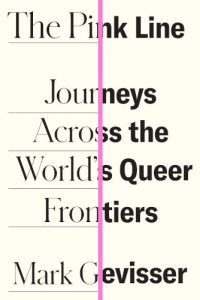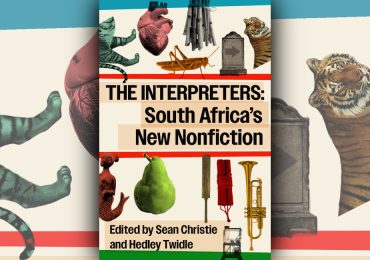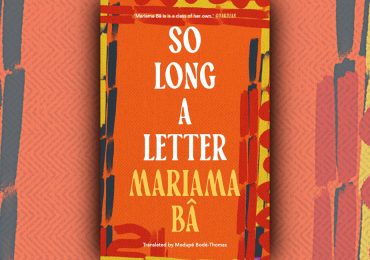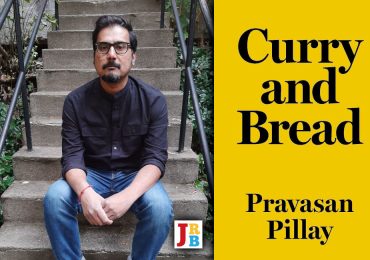The JRB presents an excerpt from The Pink Line: Journeys Across the World’s Queer Frontiers, the new book by Mark Gevisser.

The Pink Line: Journeys Across the World’s Queer Frontiers
Mark Gevisser
Jonathan Ball Publishers, 2020
~~~
Read the excerpt:
Ahwet el-Banat it was called: the Girls’ Café.
The name was painted onto a banner by Amira and Maha and hung over the entrance to the converted shop front that they leased in June 2012. On a decaying pedestrian street in downtown Cairo, the girls’ red plastic chairs jostled with the black or white or orange ones of neighbouring cafés, the waiters of each establishment pulling them periodically back into line, a rippling quilt of competing territories along the street’s chipped flagstones. Downtown Cairo had been remodelled in the late nineteenth century to evoke the cosmopolitan modernity of Paris: regimented facades with Art Nouveau detail and wrought-iron barriers around green islands. As night fell a century later, in the dying weeks of the Egyptian revolution that had overturned the country, the elegant streetlamps flickered on unexpectedly (everything else was in a profound state of disrepair), in a play of light with the glowing coals in the shisha pipes being lit in dozens of sidewalk cafés. Around one table would be clustered long-haired university students; around another, office workers playing backgammon or shopkeepers on break. It was the sweltering summer of 2013, just before the storm.
In the later years of the Hosni Mubarak regime, Cairo’s wust-el-balad (downtown) had been the site of ever-increasing protests, and downtown became a byword for freedom and modernity, for a place where women might sit in public and smoke shisha without a veil, where men and women could sit together or even hold hands. Although the scene was still largely male, mixed groups were more common here by 2013, as were fervent late-night debates about politics and society. This was the revolution’s liberated zone, and the Girls’ Café seemed part of it.
The Girls had their regulars, like the well-dressed older man who settled in every evening with his newspaper for an hour or two, or the immaculately coiffed legless woman who rolled there in her wheelchair at six on the dot to smoke her shisha. There was also, always, smoldering on the periphery, the muscular local thug who had appointed himself the Girls’ protector. As the night drew in, fragrant young men in sharply pressed shirts and tight jeans would wander over, alone or in little groups, pulling chairs up to ever-expanding tables. Many of them identified as ‘ladyboys’—the queer Egyptian vernacular for transgender—and although they wore male clothing on the street, their female selves escaped: in a shriek that would pierce the street’s steady thrum, in an arm shot skyward, an extravagant greeting, or even a catfight. These would be alarm bells to Amira, who would come rushing over to shush them before returning to her shisha at the ‘bosses’ table’ by the door, around which were often gathered a group of lesbian women, quieter and less concerned than the men with physical appearance.
Amira was brisk and butch and had a stern manner that brooked no dissent but broke easily into laughter. She tucked her shoulder-length hair into a baseball cap, and wore jeans low on the hips. Maha, her wife (they had married privately—and obviously illegally—the previous year), was a little younger, buxom and warm, with an inviting smile under hair that fell down one side of her face. Maha worked at a foreign embassy and came over to the ahwa after work in the evenings to help out. In the months following the revolution, she had helped found Egypt’s first LGBT organisation, Bedayaa (the word means ‘beginnings’), and although she was not out of the closet, she was passionate about this new cause in her life.
As you sat at the Girls’ Café you could discern, as the night wore on, the song lines of post-revolution queer Cairo: down to the El-Horreya bar or the Greek Club on Talaat Harb, both of which sold alcohol, over to Tahrir Square to cruise, if that’s what you were looking for. You could spend the night flitting between tables at the Girls’ Café and another queer-friendly ahwa around the corner, burrowed out of the lobby of a grand but derelict old block with tables spilling onto a busy street. The traffic never really stopped, but in the early hours of the morning, once it had calmed down a bit, customers would commandeer the thoroughfare itself, the late-night taxis dodging tables bubbling with shisha and gossip.
‘After the revolution, everyone was on the streets, as never before, the gays more than anyone,’ Maha said to me, in fluent English. ‘One evening, it was April 2011, a big group of us were sitting at that café over there’—she pointed to a more formal establishment—‘there were some very feminine gays with us, wearing makeup and women’s clothes, and laughing loud. The waiters went and called the military police, who came over and wanted to search the bags of the boys.’ The police found makeup in a handbag, which the women tried to insist was theirs. We giggled at the notion of the butch Amira pretending to own makeup, and the police were similarly unconvinced: they admonished the group for inappropriate behaviour, and left.
‘But the workers at the café were not happy,’ Maha continued. ‘They started cursing the boys and a violent fight broke out. Two of our friends were held hostage.’ The military police returned, and everyone dispersed, but Maha and her friends were certain they had been followed home. This was two months after the Tahrir Square revolution, which had forced the resignation of Mubarak, and the military was clamping down in an attempt to restore order; Amira and Maha and their friends panicked, particularly after Maha started getting phone calls from a man ‘asking creepy questions’. The friends hunkered down in the couple’s downtown apartment, not going out to public places until about two months later.
‘We realised, “This is crazy. We didn’t fight a revolution to stay inside,”’ Maha remembered, and out of this realisation was hatched the ahwa. The notion, midwifed by the revolution, was simple, yet revolutionary itself. As Amira put it to me in Arabic (she did not speak English): ‘Gay people deserve a place like everyone else. A place where they can sit outside, safely, without harassment or being bothered.’
It would take a year for them to make it happen, and then a year again before it was shut down.
ONE AFTERNOON, MAHA came to meet me at the Girls’ Café after she had finished work. I was in Cairo to understand how the Pink Line was being staked here, in this great city seemingly liberated by the Arab Spring and the 2011 revolution. I knew I wanted to write about the Muslim Middle East, and my short list also included Istanbul and Beirut, but I chose Cairo precisely because being out in the open was so new here, and because the Mubarak regime had been so repressive. Amira and Maha and their clients were the very first Egyptians to be open in public, despite the fact that there had always been a discreet scene in the country: in private homes and some restaurants for middle-class people, and in the hammams, the public baths, for poorer ones. And gay sex tourism had always been one of Cairo’s draws, in a society where male homosexual sex was a more acceptable alternative to pre- or extramarital affairs, so long as it was on the down-low and you were the active partner. Partly for this reason, Egypt had already been a Pink Line frontier, during the horrendous crackdown following the raid of a floating club on the Nile called the Queen Boat in 2001.
Maha and I settled in at the bosses’ table, sipping cold hibiscus tea and watching Amira, hands on hips, dressing down a supplier.
‘She’s tough!’ I laughed.
‘That’s why I like her.’ Maha laughed back. ‘She has to be tough. She is the only woman who owns an ahwa in the whole of downtown. I think this causes as much trouble for us as our gay customers. It drives the other owners crazy that there’s a woman here on the same level as them, it’s like we are taking not just the customers but the authority from them, too. They sometimes even taunt Amira that she must be sexually frustrated because all her customers are khawalat (the Egyptian word for faggots, derived from the word for traditional transvestite dancers).
Amira had been threatened so many times—or the ahwa’s property broken—that the women frequently thought of closing the place down. They were also becoming increasingly exasperated by some of their customers who just could not seem to tone down the camp, perhaps intoxicated by the possibility of being themselves out in the open for the first time. The provocation for a fight was often a customer’s inappropriate cruising of other men.
I thought of a line I had just read in Shereen El Feki’s book about sexuality in the Arab world, Sex and the Citadel—‘The ahwa is an intensely masculine place, you’d swear they put testosterone in the shisha’—as Maha told me the story of the worst incident yet. ‘It was some months ago. Two of our male customers, very feminine, were getting some pizza from the restaurant over there and some of the local thugs came to our workers and said, “It will be good for everyone if these people stop sitting here. If we see them here again, we will beat them up.” Of course, we did not tell our customers to go away, and later in the evening, a group of workers came over from the next-door café’—she gestured to the chairs across an invisible line just a few feet away—‘they hit one of the gay guys, but the other ran away. Amira was trapped inside.’
Amira, who had joined us by this point, picked up the thread: ‘One guy started to tease the [gay] boy with a laser. When the boy asked him to stop, he started beating him, and called the others. They came with sticks. They broke up everything, they threw broken chairs around, they beat up my workers. When they stopped breaking everything, I picked up a chair from the inside, and I walked outside. I kicked aside some of the broken chairs, and I put my chair down. Right here, where we are sitting now. I asked my workers to prepare me a shisha.’ Amira looked her assailants in the eye and dared them: ‘So. Is there anything else you would like to do?’
~~~
*This is an edited extract from The Pink Line by Mark Gevisser.
About the book
‘Gevisser has produced that rare book of non-fiction – rigorously researched, meticulously analysed and beautifully crafted. The Pink Line is not just necessary reading for those who care about justice, it ought to be mandatory.’—Sisonke Msimang, author of Always Another Country
‘Both global and intimate, both analytical and richly narrative, The Pink Line follows across continents the preeminent global divide of the early 21st century: the rights to sexual orientation and gender identity. Hugely ambitious and brilliantly executed, it is an engrossing and essential read.’—Jonny Steinberg, author of One Day in Bethlehem
Six years in the making, The Pink Line follows protagonists from nine countries all over the globe to tell the story of how ‘LGBT Rights’ became one of the world’s new human rights frontiers in the second decade of the 21st Century.
From refugees in South Africa to activists in Egypt, transgender women in Russia and transitioning teens in the American Mid-West, The Pink Line folds intimate and deeply affecting stories of individuals, families and communities into a definitive account of how the world has changed, so dramatically, in just a decade. And in doing so he reveals a troubling new equation that has come in to play: while same-sex marriage and gender transition are now celebrated in some parts of the world, laws to criminalise homosexuality and gender non-conformity have been strengthened in others.
In a work of great scope and wonderful storytelling, this is the groundbreaking, definitive account of how issues of sexuality and gender identity divide and unite the world today.
Mark Gevisser’s previous books include the award-winning Thabo Mbeki: A Dream Deferred and Lost and Found in Johannesburg: A Memoir. He writes frequently for Guardian, The New York Times, Granta, and many other publications. He helped organise South Africa’s first Pride March in 1990, and has worked on queer themes ever since, as a journalist, filmmaker and curator. He lives in Cape Town.





